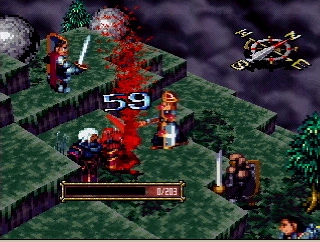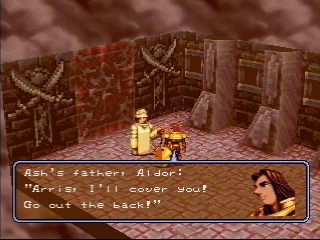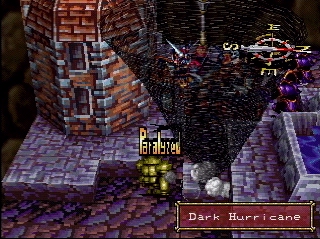 | Vandal Hearts - Retroview |  |
Strong Brains VS. Bad Technology -- Part I By: Noj Airk
| Review Breakdown |
| Battle System |
10 |
| Interface |
8 |
| Music/Sound |
5 |
| Originality |
8 |
| Plot |
8 |
| Localization |
8 |
| Replay Value |
6 |
| Visuals |
2 |
| Difficulty |
Medium |
| Time to Complete |
8-15 hours | | | Overall |  |
| Criteria |
 |
In a day like today, it is easy to see games with more
glamour than a Hollywood flick, and the brains of a
half-eaten Dorito. Old school RPG’s, which can soon
be classified as 32-bit RPG’s, are starting to be
passed up for the games in which being smart or not is
a coin toss. However, one game that will most likely
immediately and quite harshly be neglected will be
Vandal Hearts, one of the earlier and best of the
Strategy/RPG genre mixup. Why is this? Well, it’s
mostly because of the casing in which this game comes
in. The graphics are painful, the music mediocre, and
even the jewelcase design weak. Even at its release
several years back, it was far from the more
impressive titles upon its release; it doesn’t require
several years of gaming evolution for this game’s
technology to quite unimpressive. What people will
not know for a long time in the future is that if they
actually sat down and played it, Vandal Hearts is
quite an intelligent game, with some great strategic
requirements for the players, and a solid plot.
While Final Fantasy VII was a superb game, we have one
thing to really thank it for: allowing the idiotic and
impatient people into calling themselves
“role-players.” Making RPG’s mainstream was its
intention, and it succeeded, in my opinion, too well,
and as such, many games that were almost promised
success due to their intellects were discarded by the
masses as not being worthy of their time, traded for
the sparkly RPG’s made for money-making purposes.
Vandal Hearts is an older game, and its technology
shows well beyond its age, as the same principles have
been used since, and increased to amazing amounts
today. The solid plot and battle system are really
all that this game has to offer, and that was all it
had to offer only a couple of years after its
creation.
Like I stated before, the battle system is truly a
winner, perhaps even superior to that of Final Fantasy
Tactics. The first level in Chapter 2 is one in which
your party must take out some statues which are
forcing some peaceful peasants to go mad and attack
you. Your objective: use push-able boxes and
long-ranged attacks to destroy the statues, and block
off the villagers so that you kill as few as possible.
Sadly, Front Mission 3 and Final Fantasy Tactics both
lacked the level of interaction with level for
strategic advantage that you’ll find here in Vandal
Hearts. Luckily, this is also one of the easiest
games of the genre, which I, and many others, have
associated with incredible difficulty levels, mostly
due to the fact that unlike Tactics, you will rarely
be in the instance in which every single enemy comes
at you at once. You are commonly surrounded, but only
the closer enemies will attack you, unless they are
capable of long range attacks. While the whole
square-movement system is a bit weak by the standards
made by Squaresoft’s masterpieces, and so is the
character selecting and using procedure, but with this
truly being a decently old game, it is perfectly
acceptable. If your only experience with the genre
have been with either Front Mission 3 or Final Fantasy
Tactics, think of this as switching user-friendliness
for strategy. Fair trade, eh?
 | | Great blood effects make things more fun, and brings emphasis off of attempted convincing-ness. | |
The interface is also as nice and smooth. However,
apart from some class changing abilities, there is
almost nothing that makes this game really great.
Characters each have to select different types of
weapons and armor, and the character classes are quite
varied, but those are in every other games with those
features. You can wander around the site-to-site map,
similar to that found in both Final Fantasy offshoots:
Tactics and Mystic Quest. However, backtracking does
you almost literally no good here, as you cannot fall
under attack in a battle that isn’t pre-determined,
and very rarely will people in the pubs say anything
different than they did when you first showed up in
town.
The sound suffers from some limitations too. I recall
playing Biohazard CODE: Veronica X recently before
playing a bit of this game, and the mediocre in itself
sound of Vandal Hearts simply couldn’t compare to the
superb sound of the great survival horror game. So,
as such, maybe I’m being a bit harsh on the sound
rating for Vandal Hearts. However, this game came out
only six months before Final Fantasy VII, and it also
pales in comparison to that as well. The sound
effects are quite cartoony, but rather solid. Whether
you consider it a good thing or not, is completely up
to you. I liked it, even though it was a tad silly,
and some sound effects grated at my nerves. Overall,
the sound effects, just like they ussually stand in
games, aren’t worthy of much mentioning, and quite
unimportant. What really can upset the person,
however, is the music.
Once someone said: “The music in Vandal Hearts neither
weakens nor strengthens the game to any real extent.”
That is true, although, it is being a tad nice to the
soundtrack. The soundtrack has three limitations to
it: the synthesization, the normal track, and the
powerful track. The synthesization was decent when it
came out, a tad above that in Final Fantasy VI, but by
todays standards, weak. The normal track is about the
same, non-great, non-terrible classification. While
Nobuo Uematsu has composed many weak tracks, even in
his glorious fourth and sixth entries to his series,
but his were still a notch above what you’ll find
here. However, what really hurts the soundtrack is
the tracks that stand out; there aren’t any. Chrono
Cross had a similar problem, but at least all of the
tracks in that game were great in themselves. Even
the sometimes painful to listen to Final Fantasy VIII
musical score has some tracks that alone more than
warrant purchasing the soundtrack. This game is
almost totally void of those.
The plot, however, ranks more along side the battle
system than the epic musical score or the eye-candy.
The plot is similar to that of Final Fantasy Tactics,
yet when on the same wavelength, Vandal Hearts is
quite weaker. Some players may be attracted to this
game due to the recent re-release of Final Fantasy
Tactics, and may be turned off by the similarities.
However, luckily, it soon blossoms into a plot that is
almost totally different. This game isn’t one to
really be felt like Tactics, as it is more of a
relic-hunting, sometimes time altering adventure. It
has a cross between Chrono Trigger and Legend of Mana
as much as Final Fantasy Tactics (despite that the
main character talks). The game takes place after a
successful revolution against the royal families, in a
long and hard blood feud. However, after a generation
of being degraded, the nobles start a hunt for
artifacts to prove that they were the descendants of
Toroah the Messiah, and as such, they would have the
right to be the rulers of the land. The plot twists
are commonly weakly told, but luckily, they’re always
interesting enough to keep interest, and one plot
twist near the end is one that will go down in my book
as one of the greatest plot twists ever.
 | | Some nice scenes really move a nice story at a good pace. | |
The speech isn’t at all like Final Fantasy Tactics.
It is more realistic in Vandal Hearts, more well
translated, and almost completely without poetry. The
characters are more about speaking their lines, in
more of a manor that Hamlet’s mother said: “More
matter, less art!” The main trio: Ash, Clint and
Diego, are almost identical to the normal trio you’ll
find anywhere else. They mostly remind me of Sion,
Kou and Volt from The Bouncer; one is the lead, who is
brash with a less than perfect past, one is strong and
serious, and one is the comic relief. The lines
themselves are a tad bit stereotypical, but nothing’s
too bad. It seems apparent that character development
was something Konami decided would only really happen
at the plot sequences, for outside of them, there is
almost never any moments of conversation; not even at
the local bars.
This game is rather linear, and unless you attempt to
carry out the one secret side quest, this game won’t
ever really change besides battle for battle. True,
the battles are very fun, and it is right up my alley
to play it over and over again, simply because it had
a nice plot, and killing the baddies is good fun. Not
to mention, replaying this game, as well as others I
have beaten in the genre keep my mind sharp and ready
for anything the genre will throw at me later. The
one side quest I mentioned was a search for six keys,
in which with them, you can unlock the ultimate class,
and an alternative, “true” ending. However, I am only
recently attempting this conversion, but it isn’t
enough alone for anyone to really want to try it
again. However, luckily, this game is quite short,
and playing through it again isn’t too much of a
hassle anyway.
Now, where would my argument about bad technology be
without bad graphics? Well, it wouldn’t exist, would
it? Luckily, for my sake while writing this, but
unlucky for the sake of all while playing this game,
bad graphics are a rather pleasant way of describing
this nightmarish technical light show. The visuals in
this game are primarily composed sprite characters,
and polygon backdrops. Polygons, however, might not
be fitting, as all landscape polygons are really
either square, or rectangular. The characters are
single sprites for each class, character, and
situation; direction does not fall into the equation.
True, it didn’t in Final Fantasy Tactics either, but
at least there the men weren’t carrying their weapons
out in the open. Here, when the camera spins, your
men will go from being right handed to being left
handed. These characters are as such, not overly
convincing, and the location textures don’t fare any
better either.
Now, I can understand this game playing like Final
Fantasy Tactics did in terms of style, but being
weaker, but sadly, it’s not that simple. This game is
not ugly due to the crude graphics themselves, but the
fact that the game shows its graphics as if they were
the greatest graphics in the world. After an attack
by a character, the camera slowly pans around them,
just like in Front Mission 3, only closer. And trust
me, close up shots of ugly textures and square shaped
polygons, is a very hard to swallow sometimes. The
spells also follow the “look at me, I’m beautiful”
attitude, as they fare little better. These spells
can last up to a good twenty seconds or so, and all
they usually are, are weird polygon configurations.
Behind every map, also, is a single background texture
that scrolls past, like it were the borders of the
world. While it doesn’t look too bad itself, the
moving backdrop to the still map really hurts the
eyes, and this pain does not subside after long
exposures to the game.
 | | Hurts, don’t it? I meant the eyes. | |
Vandal Hearts is a very good game, only shrouded in
bad graphics, weak sound, and an unoriginal interface.
The core of the game, as common with the genre, is
the plot and battle system, and both are shining today
as they did when the game was first released, which is
more than can be said about its technological aspects.
Its fun, it’s creative, and its sometimes hard to
make it through. I wish that a new drug could come
out, one that they would call “the eyesore medicine.”
Give me this medicine and Vandal Hearts any day! Give
me Vandal Hearts…most days, but certainly not all.
|










